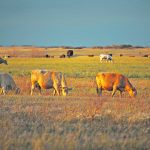Initial research found surprising links between cattle efficient at digesting fibre and methane emissions
Results of four interconnected studies on cattle forage intake and methane emissions have yielded useful findings, says a University of Saskatchewan researcher. “Our hypothesis is that cattle with greater digestible fibre intake would have positive RFI (residual feed intake) because they eat more,” said Dr. Gabriel Ribeiro, an assistant professor and the Saskatchewan Beef Industry […] Read moreTag Archives Gabriel Ribeiro

Feds put enteric methane under the microscope
Enteric methane will be the federal government’s next big target that agricultural producers are expected to aim for. It’s the methane cattle produce when they digest food and is released mainly through respiration. Agriculture Canada made two big announcements recently that brought methane to the forefront of its climate change policy. In December, at the […] Read more

Implants seen as climate solution
The Canadian cattle industry is facing a quandary. With the global population expected to reach 9.7 billion by 2050, beef production must increase to meet rising demand. On the other hand, there is greater pressure to reduce greenhouse gas emissions in agricultural production. Environment and Climate Change Canada says agriculture contributes about eight percent of […] Read more

Ergot recommendations tightened
New research suggests increased caution with ergot-infected feed; maximum levels are increased to one part per million
Cattle producers in Western Canada should pay more attention to ergot levels in their feed after new research found that previously recommended levels should be lower. Research conducted by Dr. Gabriel Ribeiro and others at the University of Saskatchewan has led to recommendations that cattle not consume feed with more than one part per million […] Read more



